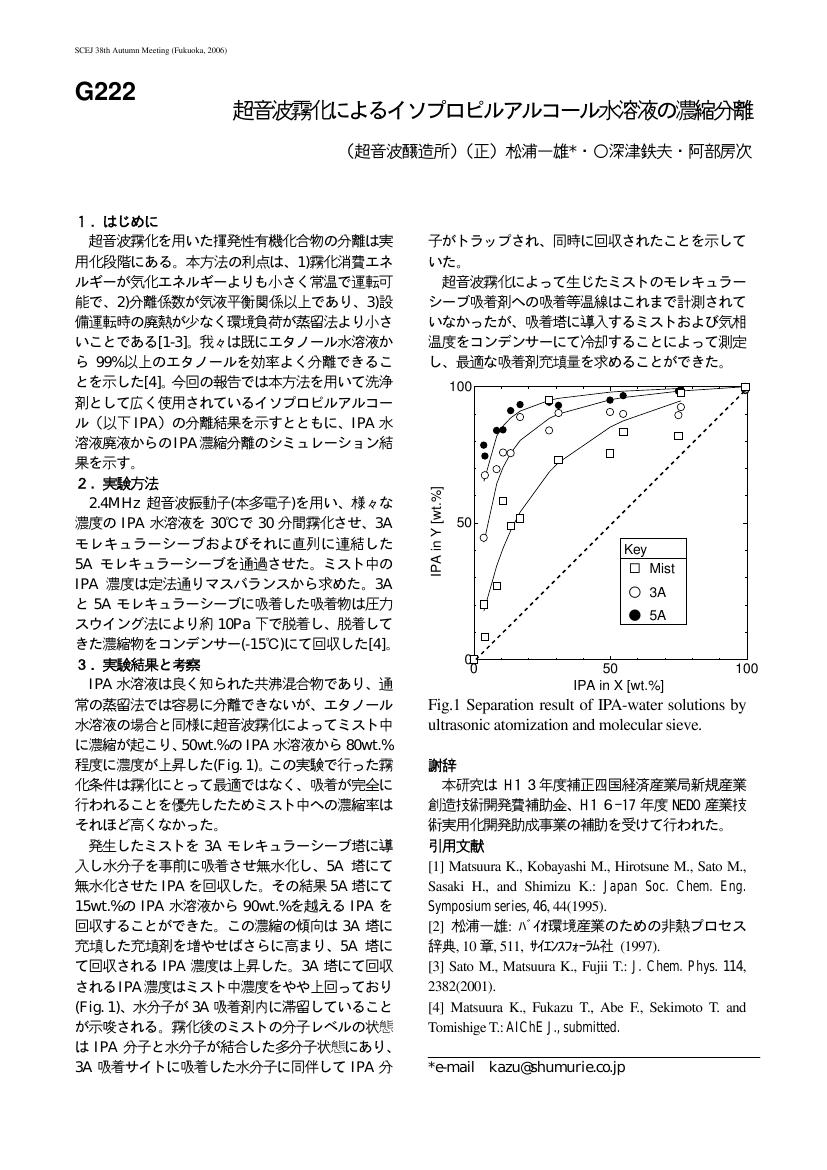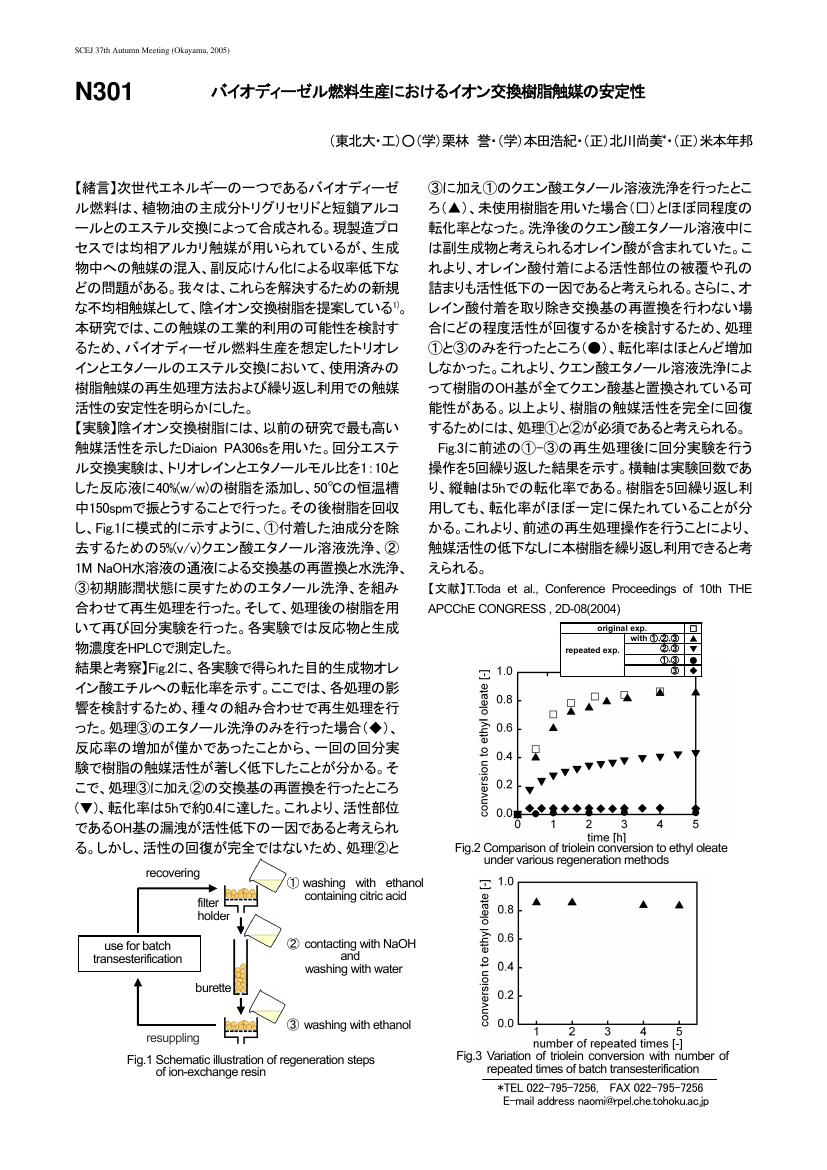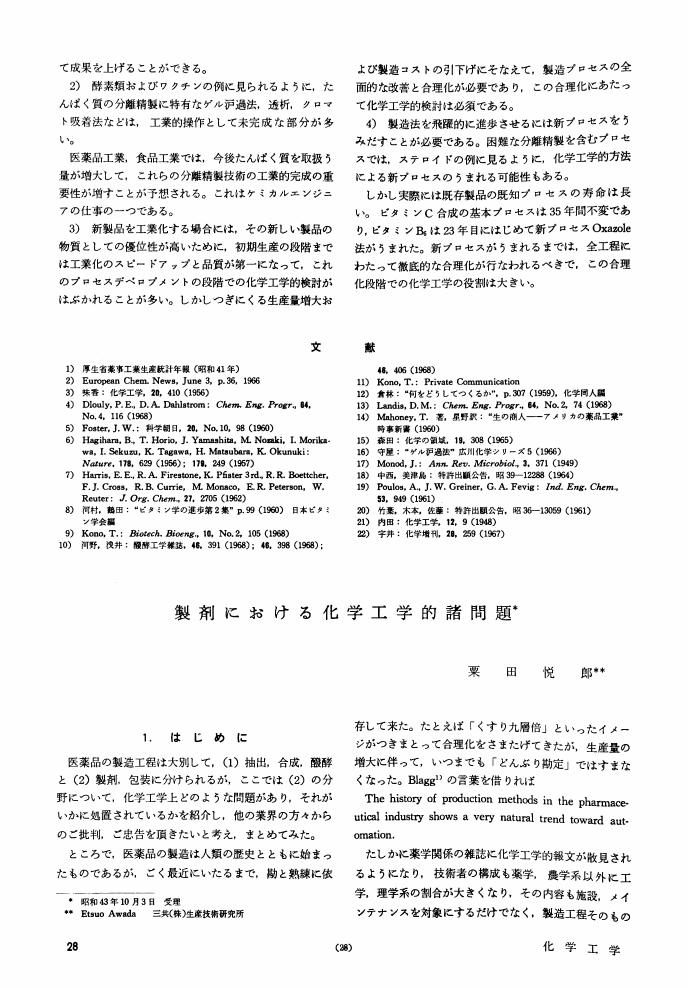1 0 0 0 固定化ヒスチジンによるパイロジェンの回分吸着除去
- 著者
- 竹永 勇治 縄田 雅裕 坂田 信行 瀬沼 勝 渡辺 泰三 佐藤 忠司 土佐 哲也
- 出版者
- 公益社団法人 化学工学会
- 雑誌
- 化学工学論文集 (ISSN:0386216X)
- 巻号頁・発行日
- vol.17, no.1, pp.204-206, 1991
- 被引用文献数
- 1
The removal of pyrogen using immobilized histidine by a batchwise method was investigated. The pyrogen adsorption depended on ionic strength and was influenced by the shaking speed. The concentration of pyrogen in liquid phase decreased to less than 0.1 ng/cm<SUP>3</SUP> from 20 ng/cm<SUP>3</SUP> by batchwise adsorption with the immobilized histidine when the ionic strength was lower than 0.10 mol/dm<SUP>3</SUP>. This indicates that pyrogen could be removed practically by batchwise adsorption.
1 0 0 0 OA イオン交換ゼオライト触媒を用いたアセトンからのイソブテン選択合成
- 著者
- 山崎 聖治 今野 大輝 中坂 佑太 二宮 航 多湖 輝興 増田 隆夫
- 出版者
- 公益社団法人 化学工学会
- 雑誌
- 化学工学会 研究発表講演要旨集 化学工学会第42回秋季大会
- 巻号頁・発行日
- pp.634, 2010 (Released:2011-01-09)
1 0 0 0 ノンエレメントミキサーの対流混合メカニズムに関する検討
- 著者
- 兪 善昊 杉川 裕介 植田 利久
- 出版者
- 公益社団法人 化学工学会
- 雑誌
- 化学工学論文集 (ISSN:0386216X)
- 巻号頁・発行日
- vol.35, no.4, pp.357-363, 2009-07-20 (Released:2009-07-30)
- 参考文献数
- 13
- 被引用文献数
- 1 1
ノンエレメントミキサーは,主流に,主流流路に垂直に同一間隔で接続された複数の支流から流体を注入させることにより,流体が引き伸ばしと折り畳みの効果を受け,混合を促進させるミキサーである.主流流路中心軸に垂直な断面の混合の様子をレーザ誘起蛍光法(LIF)を用いて可視化し,得られた断面像から界面の大きさの時間変化の様子を明らかにし,対流混合促進のメカニズムについて検討を加えた.支流本数n,支流押し出し周期Tpを変化させ,断面像観察,境界線長さLの測定を行った.その結果,以下の結論を得た.支流本数が増えるほど,すなわちnが大きくなるほど,混合のパターンは複雑になる.特に遅延座標系の位相空間でのLの形状より,nが大きくなるとカオス的挙動を示すことが示唆された.またLは時間的に変化し,その周期はTpと一致する.Lの時間平均値Lはnが大きくなるほど大きくなる.その増加は指数関数的な増加であり,このことは本ノンエレメントミキサーが,Kenicsタイプのスタティックミキサーと同様の混合促進特性を有していることを示している.
1 0 0 0 OA 超音波霧化によるイソプロピルアルコール水溶液の濃縮分離
- 著者
- 松浦 一雄 深津 鉄夫 阿部 房次
- 出版者
- 公益社団法人 化学工学会
- 雑誌
- 化学工学会 研究発表講演要旨集 化学工学会第38回秋季大会
- 巻号頁・発行日
- pp.279, 2006 (Released:2007-02-09)
1 0 0 0 超音波霧化分離装置における運転エネルギーの最小化
- 著者
- 松浦 一雄 深津 鉄夫 阿部 房次
- 出版者
- 公益社団法人 化学工学会
- 雑誌
- 化学工学会 研究発表講演要旨集
- 巻号頁・発行日
- vol.2008, pp.904-904, 2008
- 著者
- Yu Qiu Yiqi Liu Daoping Huang
- 出版者
- 公益社団法人 化学工学会
- 雑誌
- JOURNAL OF CHEMICAL ENGINEERING OF JAPAN (ISSN:00219592)
- 巻号頁・発行日
- vol.49, no.10, pp.925-936, 2016-10-20 (Released:2016-10-20)
- 参考文献数
- 46
- 被引用文献数
- 1 28
In wastewater treatment plants (WWTPs), some variables such as BOD5 and COD that are related to effluent quality, are difficult to measure directly online due to technical or economic limitations. To deal with this problem, a soft sensor that is based on a deep neural network with a named stacked autoencoder (SAE) is developed for WWTPs. Neural networks with deep structure are superior to shallow ones when facing complex problems in modern applications, which makes them suitable for wastewater treatment processes. However, deep structures are difficult to train when using traditional learning algorithms, and there are no general guidelines for identifying the proper network structure for a specific application. In the present work, a deep learning technique called the greedy layer-wise training algorithm is employed to train a deep neural network, and a genetic-algorithm strategy is developed for identifying the number of neurons in each hidden layer. In order to demonstrate its usefulness, the proposed soft sensor is tested through the test-bed Benchmark Simulation Model No. 1 (BSM1) with different weather conditions. The results indicate that the proposed soft sensor based on a deep-structure neural network can achieve better prediction and generalization performance in comparison with commonly used methodologies.
1 0 0 0 OA 四川省に於ける製監と石油
- 著者
- 小林 久平
- 出版者
- 公益社団法人 化学工学会
- 雑誌
- 化学機械 (ISSN:03684784)
- 巻号頁・発行日
- vol.3, no.1, pp.41-48, 1939-03-25 (Released:2009-07-09)
1 0 0 0 OA 超臨界二酸化炭素によるイカ内臓からのドコサヘキサエン酸 (DHA) の選択的抽出分離
- 著者
- 生島 豊 畑田 清隆 斉藤 功夫 伊東 祥太 後藤 富雄
- 出版者
- 公益社団法人 化学工学会
- 雑誌
- 化学工学論文集 (ISSN:0386216X)
- 巻号頁・発行日
- vol.15, no.3, pp.511-518, 1989-05-10 (Released:2009-10-21)
- 参考文献数
- 24
- 被引用文献数
- 4 4
超臨界二酸化炭素を用いて, イカ内臓中からドコサヘキサエン酸 (DHA) の選択的抽出分離を試みた.その結果, 流通系抽出装置内に硝酸銀を担持した分離チャンバーを組み入れることにより, 昇圧過程のみで何等の後処理操作を必要とせずに, 原料中に含まれていた DHA 量の約80%を濃度90重量%以上の純度で抽出分離できた.さらに超臨界二酸化炭素への各種エントレーナー添加による抽出効率への影響が検討され, ヘキサン, 酢酸エチル, アセトン系エントレーナーにより抽出効果が向上することがわかった.また溶解度パラメーターを含んだパラメーターによって, グリセライドモデル混合物だけでなく, 本試料のような天然物へのエントレーナー添加効果を相関した.
1 0 0 0 OA バイオディーゼル燃料生産におけるイオン交換樹脂触媒の安定性
- 著者
- 栗林 誉 本田 浩紀 北川 尚美 米本 年邦
- 出版者
- 公益社団法人 化学工学会
- 雑誌
- 化学工学会 研究発表講演要旨集 化学工学会第37回秋季大会
- 巻号頁・発行日
- pp.405, 2005 (Released:2006-03-18)
1 0 0 0 OA 化学工学語彙
- 出版者
- 公益社団法人 化学工学会
- 雑誌
- 化学機械 (ISSN:03684784)
- 巻号頁・発行日
- vol.4, no.2, pp.123-125, 1940-06-10 (Released:2009-07-09)
1 0 0 0 流体密度の温度・圧力依存性を考慮した気液二相流の数値解法
- 著者
- 島田 直樹 冨山 明男
- 出版者
- 公益社団法人 化学工学会
- 雑誌
- 化学工学論文集 (ISSN:0386216X)
- 巻号頁・発行日
- vol.31, no.1, pp.15-24, 2005 (Released:2005-02-25)
- 参考文献数
- 15
- 被引用文献数
- 1 1
著者らが開発した(N+2)-field modelを圧縮性混相熱流動解析用に修正し,各相密度の温度,圧力依存性を考慮できる数値解法をTomiyamaらが提示した解法を基に構成した.本数値解法は非圧縮流れ解法の枠内で構成でき,エネルギー保存式は分離して解ける.さらに,時間刻み幅に対する制約はCourant条件であるため,圧縮性流れ用の数値解法よりも大きな時間刻み幅を用いて安定に計算を実施できる.構築した計算手法の妥当性を検証するため,三つの計算を実施した.はじめに,密度の圧力依存性を考慮した本解法の性能を検証するため,大きな静水圧差下の気泡流を計算した.計算結果から,提案した解法が気相密度低下による気相体積流束の増加を良好に予測できることを確認した.次に,ダクト壁面から流体を加熱した際の気泡流を計算し,圧力に加えて温度の変化が体積流束に及ぼす影響を検証した.これらの計算結果から,提案した解法が密度変化による気液各相体積流束の変化を良好に予測できることを確認した.最後に工業装置の計算例として,気泡塔を計算した.提案した手法により,計算時間の膨大な増加を回避しつつ,塔の性能評価に必要な各種変数(気泡径,ボイド率,流速,温度など)の計算に密度の温度・圧力依存性が考慮できることを確認した.
1 0 0 0 OA 角型攪拌槽内における粒子の浮遊化限界動力
- 著者
- 佐藤 一省 前田 法史 小川 範之
- 出版者
- 公益社団法人 化学工学会
- 雑誌
- 化学工学論文集 (ISSN:0386216X)
- 巻号頁・発行日
- vol.21, no.3, pp.632-635, 1995-05-10 (Released:2009-11-12)
- 参考文献数
- 3
- 被引用文献数
- 1 1
The minimum power of impeller required for complete suspension of solid particles, based on Zwietering's criterion, was measured for single and twin impeller systems. The effects of the configuration of vessel and the number of impellers on the minimum required power were examined.The minimum required power per unit liquid volume Pfv for a single impeller system increased gradually as the length ratio of long side to short side A/B incresed over 1.5 Pfv for a twin impeller system remained nearly constant at a lower value than that of a single impeller system in the range of A/B=1.52.25.The Pfv of a pitched-blade turbine was below 1 / 2 of the value of a flat-blade disc turbine under the same conditions and was independent of the rotational direction of each impeller.
1 0 0 0 ストレス環境下における酵母一遺伝子破壊株のフェノーム解析
- 著者
- 吉川 勝徳 田中 忠昌 永久 圭介 平沢 敬 古澤 力 清水 浩
- 出版者
- 公益社団法人 化学工学会
- 雑誌
- 化学工学会 研究発表講演要旨集
- 巻号頁・発行日
- vol.2008, pp.386-386, 2008
1 0 0 0 OA 弱塩基性生理活性物質の抽出
- 著者
- 駒沢 勲 黒見 眞 東稔 節治
- 出版者
- 公益社団法人 化学工学会
- 雑誌
- 化学工学論文集 (ISSN:0386216X)
- 巻号頁・発行日
- vol.13, no.2, pp.223-229, 1987-03-10 (Released:2009-11-12)
- 参考文献数
- 8
- 被引用文献数
- 3 4
ロイコマイシンA5, ノルエフェドリンおよびフェネチルアミンのような弱塩基性の生理活性物質の水溶液pH調整による物理抽出および逆抽出を行った.有機溶媒として酢酸ブチルおよびクロロホルムを用いた.各抽質の分配データから酸解離定数および分配係数を求めた.各抽質のカチオンと有機リン酸抽出試薬HDEHPとの錯体形成による化学抽出も行った。抽出試薬の保持率全域に適用できる抽出平衡式を求めた.いずれの抽質に対しても抽出種はHAX・2(HX), HAX・(HX) およびHAXの3種類で統一的に表現できる.ここでHXおよびAはHDEHPモノマーと塩基性物質を表す.ノルエフェドリンとフェネチルアミンの抽出特性は化学抽出の導入によって大きく向上する.しかし, ロイコマイシンは逆抽出をロイコマイシンカチオンが不安定となるpH域で実施するため有利ではない.
1 0 0 0 OA 画像処理システムを用いた結晶のオンライン色測定
- 著者
- 岡安 祥夫 片山 正樹 篠原 徹
- 出版者
- 公益社団法人 化学工学会
- 雑誌
- 化学工学論文集 (ISSN:0386216X)
- 巻号頁・発行日
- vol.22, no.1, pp.8-12, 1996-01-10 (Released:2009-11-12)
- 参考文献数
- 8
工場プラントの運転安定化, 要員極少化の技術課題の一つとして, アミノ酸 (リジン) 精製工程における結晶の色測定への画像処理技術の適用が検討された.これまで結晶溶解液の分光光度計の透過率を人手により測定し監視していたが, 常時分析はできず, オンライン測定方法の導入が望まれていた.本論では分光光度計の原理である光の透過率の式と結晶面における光反射の式との関係を解析し, 画像処理測定値による透過率の推算式を導出した.この推算式の各パラメータを, 画像処理の実験により決定することによって, 推算式により検量誤差 3% の精度で分光光度計の実測透過率を推定できることが確認された.さらにカラー画像処理システムを実プラントに設置し, リジン結晶の色の 24 時間オンライン測定を実施することによって, その実用性の評価がおこなわれた.
1 0 0 0 OA アセトンの回収プロセス-吸収法の再検討
- 著者
- 神谷 卓郎 小川 健次郎
- 出版者
- 公益社団法人 化学工学会
- 雑誌
- 化学工学 (ISSN:03759253)
- 巻号頁・発行日
- vol.26, no.2, pp.373-377, 1962-02-01 (Released:2010-10-07)
Two methods are prevalent for the recovery of acetone in an acetate dry-spinning plant. One of them is the absorption process and the other, the adsorption one. The latter, having higher recovery efficiency and less steam consumption when employed in rectifying acetone, has come to be more widely used than the former, especially with the improvement in the properties of activated charcoal. But the absorption process has such merits as safety from explosion and possibility of perfectly continuous operation. The lower recovery efficiency, which is one of its drawbacks, can be improved by the circulation of the air laden with vapour. The circulation of the air, together with the use of the multi-stage turboblower and turbine pump helps to increase the thermal efficiency of this process. From this view point, the economical evalution has been made of the absorption process into which several improvements are put by the authors.By the application of a multistage turbine pump, higher coefficient of heat transfer is obtainable between the feed and the wast of the rectifying column.Furthermore, judging from the characteristics of the equilibrium curve of rectification, there is little difference between the two methods with regard to their construction costs of equipment and their consumption amount of calorific power, when the density of the feed is kept over 2.5% in weight, although, in this case, cool water at the temperature of 5°C or so is required for absorption use.The construction cost of the equipment can be much more reduced and the power required in the operation, much more saved, when the said cool water is supplied directly refrigerated with liquid ammonia.As to the circulating air, the power of the blower will be used effectively both for promoting the efficiency of the heat exchanger and for heating the air by increasing the compression ratio.Table 1 shows the comparison between the old and the new absorption processes with respect to the utility and the construction cost, and Table 3, the results of the actual operation carried out in the authors' plant.
1 0 0 0 OA 医薬品における造粒について
- 著者
- 粟田 悦郎 池上 佳彦
- 出版者
- 公益社団法人 化学工学会
- 雑誌
- 化学工学 (ISSN:03759253)
- 巻号頁・発行日
- vol.26, no.2, pp.384-388, 1962-02-01 (Released:2010-10-07)
- 参考文献数
- 43
1 0 0 0 OA 製剤における化学工学的諸問題
- 著者
- 粟田 悦郎
- 出版者
- 公益社団法人 化学工学会
- 雑誌
- 化学工学 (ISSN:03759253)
- 巻号頁・発行日
- vol.33, no.1, pp.28-34, 1969-01-05 (Released:2010-10-07)
- 参考文献数
- 22
1 0 0 0 OA 醗酵工業における通気撹拌
- 著者
- 三浦 喜温
- 出版者
- 公益社団法人 化学工学会
- 雑誌
- 化学工学 (ISSN:03759253)
- 巻号頁・発行日
- vol.33, no.1, pp.41-46, 1969-01-05 (Released:2010-10-07)
- 参考文献数
- 50
1 0 0 0 OA 研究と経営
- 著者
- 福島 達 味香 修
- 出版者
- 公益社団法人 化学工学会
- 雑誌
- 化学工学 (ISSN:03759253)
- 巻号頁・発行日
- vol.38, no.10, pp.693-696, 1974-10-05 (Released:2010-03-15)
- 被引用文献数
- 4








